The Dover Strait convoy route was vital in keeping the industrial heart
of London alive. The power stations of London, in fact most of Britain
were fired by coal from the coalfields of Wales, Northumberland and
North York. Coal was also the life blood of the railways, shipping and
manufacturers. At the height of production the demand for coal peaked
at 30,000 tons per week.
To
deliver the coal the convoys were required to sail one of two routes:
Down
the east coast through "E Boat Alley" to London Docks, and
down the west coast, through the Bristol Channel, The English channel,
Dover Straits, Thames Estuary and to the London Docks.
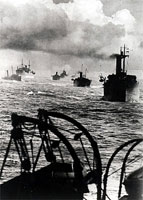 |
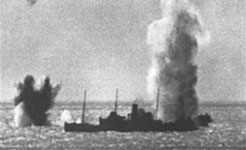 |
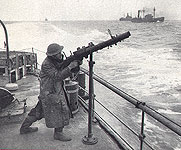 |
| Convoy sailing north • Ship near Dover narrowly missing a shell fired at Cape Griz Nez • DEMS Gunner (Defensive Equipped Merchant Ships) using a Lewis Gun - a mostly unreliable and out-dated machine from the Great War. |
Over five hundred convoys sailed over the course of the war (1940-1945) or
approximately one every three days. This effort required the small ships
of the Royal Navy and the colliers of the Merchant Navy to expend almost
superhuman effort to maintain the flow of coal.
The battle area become known as the Narrow Sea. Bordered by the French,
Dutch and British coasts this area was approximately 400 miles long,
110 miles wide at its widest and a bare 22 miles at its narrowest. A
relatively shallow sea, there were shoals and sandbars scattered throughout
the area. To further restrict the ships passing this way were minefields
laid by both sides, not to mention the wrecks of ships narrowing the
passage further. In some places the convoy sailed single file to pass.
The convoys would form up at Glasgow and from there proceed south along
the West Coast of Scotland and Wales. Ships would join from South Wales
at the Bristol Channel then the convoy would sail around Land’s End
and on to the English Channel. They entered the battle area with a typical
escort of two destroyers and six large and heavily armed "Football"
Class trawlers (750 ton). When the convoy was off Falmouth four escorts
from Plymouth Command would join to boost the escort. These escorts,
normally destroyers, were relieved by ships from Portland Command. Off
the Isle of Wight these ships were relieved by four escorts from Portsmouth
Command. The convoy with its twelve escorts would proceed to Dungeness
where the Dover Command escorts, minesweeping trawlers, would relieve
those from Portsmouth. The Dover Command ships would remain with the
convoy up to the Thames Estuary where the escorts from Thames Command
would take over. The Dover ships would pick up a westbound convoy and
slowly take them back along the same route.
Each Command had its own problems with the enemy and were equipped with ships
to match those problems. The Falmouth, Plymouth, Portsmouth escorts
were destroyers employed to combat the 40 plus German destroyers that
operated from Cherbourg and Le-Havre. The South Coast of England was
the scene of many furious destroyer battles particularly at the favourite
hunting ground of Lyme Bay. Dover Command however, had little use for
destroyers and its location within the range of the cross Channel guns
mounted in France made it too risky to station large ships. The last
destroyer HMS Codrington had been sunk in the harbour by these guns
in 1940. Dover Command boasted:
24 Armed Trawlers fitted for minesweeping. These were organised into
six groups of four ships.
40 Motor Torpedo Boats (MTB) and Motor Gun Boats (MGB).
30 Motor Launches (ML) , Motor Anti Submarine Boats (MASB) and Air Sea
Rescue Launches.
2 Tugs, the Lady Duncannon and the Lady Brassey as well as six auxiliary
vessels.
The constant threat of shelling from France, both in harbour and at sea
coupled with the more usual threats of air and surface attack not to
mention being blown out of the water by mines, kept the crews of Dover
Command under considerable stress. To counter this stress the Command
enjoyed more than the usual amount of leave. Each week one of the groups
were stood down for boiler cleaning and leave. This meant the crews
could escape from Dover area every six weeks.
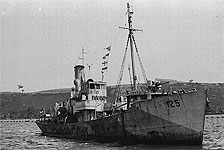 |
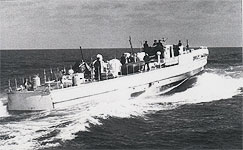 |
| HMT Grimsby Town one of the ' Football Class' armed trawlers |
Fast moving menace to Allied shipping the Schnell Boot (or E-boat) |
The constant threat of shelling from France, both in harbour and at sea coupled with the more usual threats of air and surface attack not to mention being blown out of the water by mines, kept the crews of Dover Command under considerable stress. To counter this stress the Command enjoyed more than the usual amount of leave. Each week one of the groups were stood down for boiler cleaning and leave. This meant the crews could escape from Dover area every six weeks.
However, to earn this extra leave the ships put in a full five weeks in at sea. A typical period at sea would see a trawler group carry out minesweeping of the Channel on a daily basis, convoy escort approximately every three days, independent night patrols to intercept minelayers and other duties as required. This last cause is commonly used by the navy to cover all possibilities from ferrying people over to or back from the French coast to delivering hot meals to army outposts.
The battle area for Dover Command was from a line between Hythe, east of Dungeness and Cape Gris Nez then back to South Foreland. At the focal point of this area, called "Hellfire Corner" by those fortunate participates, was the cross Channel guns at Cape Gris Nez. These guns, of various calibre, were deployed in four batteries:
the Lindemann Battery made up of three 16 inch guns.
The Goodwins gave way to the North Sea. This area was subject to mining, E Boat attack and air attack. Just before the Dover ships passed the escort to the Thames Command at the end of the Dover Striats. The convoy would enter another area favoured by the German Air Force.
In addition to the wrath of the enemy the ships of Dover Command and the laden colliers would have to withstand the weather. This mix of storms and the mixing of the warm Gulf stream with the Arctic waters of the North Sea produces wild weather. In calmer conditions, the mixing of warm and cold waters makes fogs common.
Not every convoy faced the worst of weather or the wrath of the enemy, in fact some passed like a Sunday picnic. However, now and then the enemy threw all he could muster in an attempt to block the channel and stop the flow of coal. He never succeeded.
|